PART III: MEDALS, COINS, PORTRAIT MINIATURES, BUSTS & FIGURES

No. 118
118. [FIRST FRENCH EMPIRE]. DENON, Dominique Vivant, Baron Denon [French, Artist Scholar, 1747-1825] (Designer), ANDRIEU, Bertrand [French, Sculptor Medalist, 1761-1822], and Alexis J. DEPAULIS [French, Sculptor Medalist, 1792-1867]. 1 5/8 inches in dia. bronze table medal. obverse: “Napoleon Emp. et Roi.” (right-side portrait head profile of Napoleon wearing laurel crown) signed in the cast: “Andrieu F.” reverse: “Rome. Paris.” Denon D. MDCCCIX.” (left-side portrait head profiles of allegorical representations of Rome and Paris) signed in the cast: “Depaulis F.” [France, Paris Mint: 1809]. $150
Medal commemorating the proclamation of Rome as the second capital of the French Empire. By a decree of the senate which adopted a SenatusConsultum at Paris, Rome was united to the French Empire and the Pope deposed as the temporal ruler.
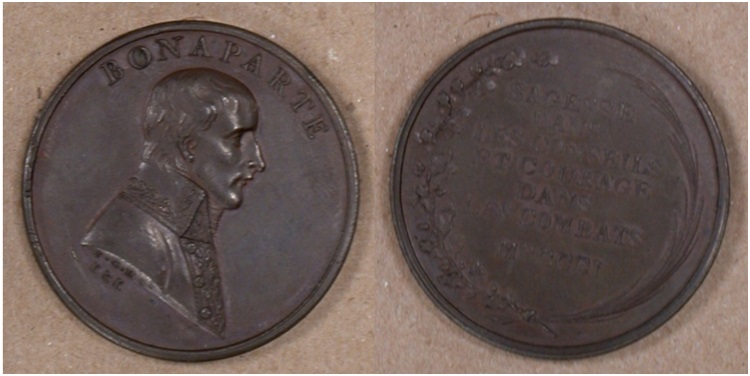
No. 119
119. [FRENCH CONSULATE ERA] .I.G.H. [French, Sculptor Medalist, active 1801]. 1 1/2inches in dia. bronze table medal. obverse: “Bonaparte” (right-side, head and shoulders portrait profile of Napoleon as First Consul) signed in the cast: “I.G.H.” reverse: “Sagesse dans les Conseils et Courage dans les Combats MDCCCI” (text with oak and palm leaf border wreath). $100
The Consulate [1799–1804]: French government established after the Coup of 18–19 Brumaire [Nov. 9–10, 1799], during the French Revolution. The Constitution of the Year VIII created an executive consisting of three consuls, but the First Consul, Napoleon Bonaparte, wielded all real power, while the other two, Emmanuel-Joseph Sieyès and Pierre-Roger Ducos [1747–1816], were figureheads. The principles of representation and legislative supremacy were discarded. The executive branch was given the power to draft new laws, and the legislative branch became little more than a rubber stamp. Elections became an elaborate charade, with voters stripped of real power. Napoleon abolished the Consulate when he declared himself emperor in 1804.” (Encyclopedia Britannica).
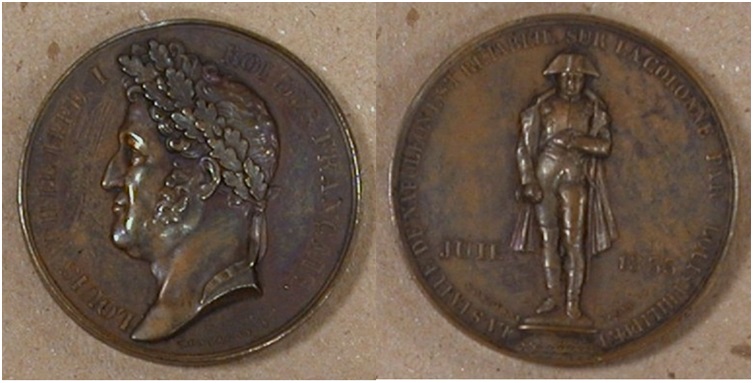
No.120
120. [FRENCH ORLEANS MONARCHY]. MONTAGNY, Jean-Pierre [French Sculptor-Medalist, 1789-1862]. 1 5/8 inches in dia. bronze table medal. obverse: “Louis Philippe I Roi des Français” (left side portrait profile of Louis Philippe wearing an oak leaf crown) signed in the cast: “Montagny F.” reverse : “La Statue De Napoléon Est Rétablie Sur La Colonne Par Louis-Philippe / Juil – 1833” (view of statue of Napoleon in uniform) signed in the cast: “Montagny Fecit”. $350
The Vendôme Column in Paris, begun in 1806 at Napoleon’s direction and completed in 1810, was erected in 1810 in place of the original equestrian statue of Louis XIV destroyed during the revolution. The monument, in commemoration of the Battle of Austerlitz, was designed by the architects Jacques Gondouin and Jean-Baptiste Lepère in imitation of Trajan’s column in Rome. The sculptural frieze was designed by Pierre-NolasqueBergeret and produced by a team of sculptors. It was superimposed by a classical style statue of Napoleon in the guise of Mars. At the Bourbon restoration the statue of Napoleon was removed and the bronze melted down and used to create the equestrian statue of Henri IV. During the July Monarchy, King Louis Philippe had a new statue of Napoleon in military uniform, produced by Antoine-Denis Chaudet, re-erected on the column.
Jean-Pierre Montagny [1789-1862], a French medalist and sculptor, was one of the most prestigious medal engravers working at le Monnaie de Paris in the 19th century. He produced many coins and medals in bronze, copper and tin commemorating French historical events in the first half of the century, his most intense production being designs relating to the Revolution of 1848.
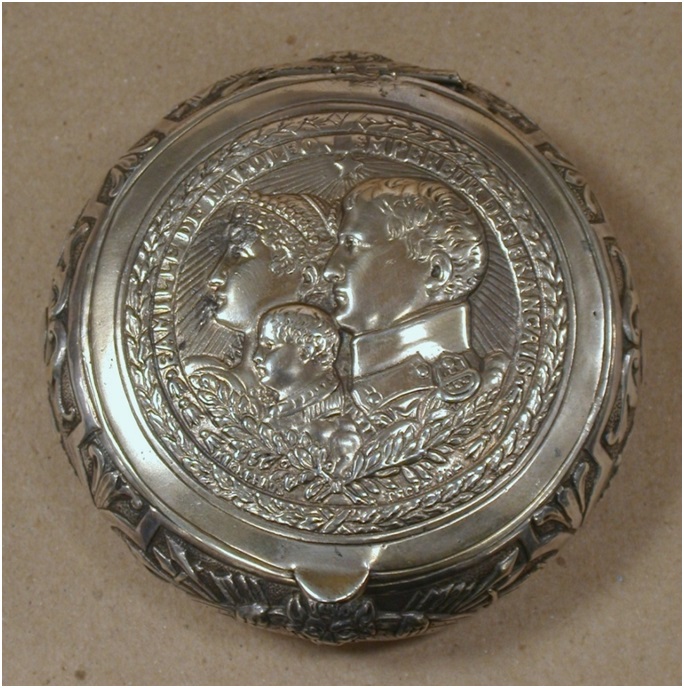
No. 121
121. [COMMEMORATIVE NAPOLEONICA, 19th CENTURY PERSONAL SILVERWARE]. “Famille de Napoleon Empereur des Français.” tobacco box, lidded container. 3 ½ x 3 ½ x 1 ¼ inches. engraved, chased and repousé silver, bearing left-side portrait head reliefs of Empress Marie Louise, Napoleon, and the infant King of Rome, in central medallion to the lid, surrounded by decorative leafy borders and titles. domed, sides heavily decorated with shields and trophies, cartouche borders, and classical decorations. signed in the relief. bearing marks to bottom. French or Belgian, c1840. $1,000
Probably produced at the time of the “Retour des Cendres” the re-burial of the Emperor Napoleon Bonaparte in Paris, France, on December 15th, 1840.
122. NAPOLEON I. EMPEROR. FIRST FRENCH EMPIRE. 5 Franc Silver Coin. design by Nicolas-Guy-Antoine Brenet. Obv: NAPOLEON EMPEREUR., laureate head of Napoleon right. Rev. RÉPUBLIQUE FRANÇAISE., Denomination within wreath, 1808. B. 37mm. dia. Grade:F12 (Fine 12). Rouen Mint: 1808. $200
123. NAPOLEON I. EMPEROR.FIRST FRENCH EMPIRE. 5 Franc Silver Coin. design byNicolas-Guy-Antoine Brenet. Obv: NAPOLEON EMPEREUR., laureate head of Napoleon right. Rev. EMPIRE FRANÇAIS., Denomination within wreath, 1810. A. 37mm. dia. Grade: F15. Paris Mint: 1810. $225
124. NAPOLEON I. EMPEROR. FIRST FRENCH EMPIRE. 5 Franc Silver Coin. design by Nicolas-Guy-Antoine Brenet. Obv: NAPOLEON EMPEREUR., laureate head of Napoleon right. Rev. EMPIRE FRANÇAIS., Denomination within wreath, 1812. B. 37mm.dia. Grade: F12. Rouen Mint: 1812. $200
125. NAPOLEON I. EMPEROR. FIRST FRENCH EMPIRE. 5 Franc Silver Coin. design by Nicolas-Guy-Antoine Brenet. Obv: NAPOLEON EMPEREUR., laureate head of Napoleon right. Rev. EMPIRE FRANÇAIS., Denomination within wreath, 1812. W. 37mm. dia. Grade: F12. Lille Mint: 1812. $200
126. NAPOLEON I. EMPEROR.FIRST FRENCH EMPIRE. 5 Franc Silver Coin. design by Nicolas-Guy-Antoine Brenet. Obv: NAPOLEON EMPEREUR., laureate head of Napoleon right. Rev. EMPIRE FRANÇAIS., Denomination within wreath, 1813. B. 37mm.dia. Grade: F12. Rouen Mint: 1813. $200
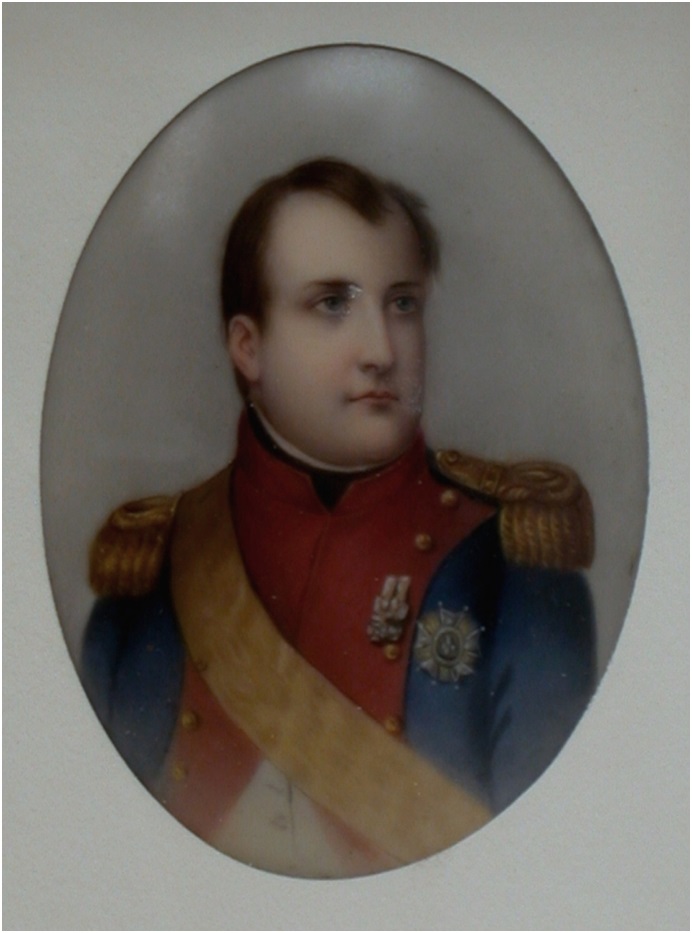
No.127
127. [COMMEMORATIVE NAPOLEONICA/PORTRAIT MINIATURE]. [Portrait of the Emperor Napoleon as King of Italy]. 3 x 2 ½ inches. colour enamel, oval porcelain miniature, bearing frontal portrait of Napoleon Bonaparte, wearing uniform of a guard regiment for the Kingdom of Italy, with ribbon of the Order of the Crown of Italy. framed and matted in a modern frame. Italy: 19th century. $700
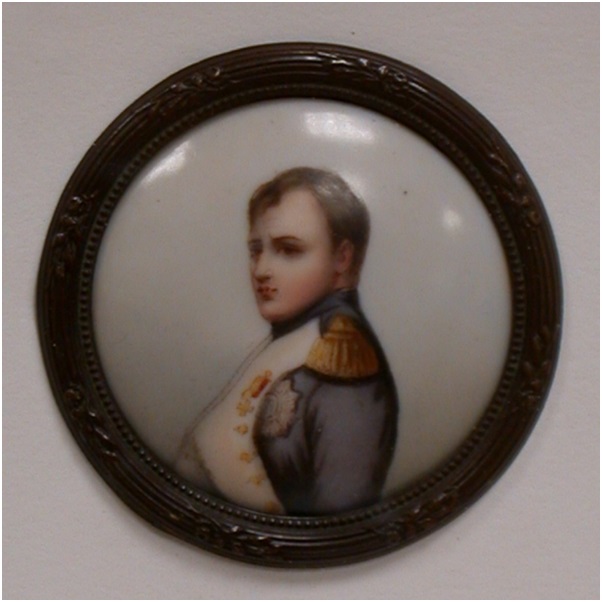
No. 128
128. [COMMEMORATIVE NAPOLEONICA/PORTRAIT MINIATURE]. after DELAROCHE, Paul [1797-1856]. [Portrait of Emperor Napoleon]. 1 ¾ inches in diameter. colour enamel, circular porcelain miniature, bearing side view portrait of Napoleon Bonaparte, taken from the painting of “Napoleon in his study” 1807, by Delaroche, mounted in circular bronze frame with decorative borders. framed and matted in contemporary frame. France: 19th Century. $500
“Delaroche was one of the most popular French painters of the early 19th century. He was born in Paris and trained by Watelet and by the famous history painter Baron Gros (from 1818)...Delaroche continued to specialize in large historical tableaux, often of a tragic nature and characterised by close attention to fine detail. He also painted portraits and religious subjects. During his lifetime his work received wider international acclaim than the paintings of Ingres and Delacroix, now considered greater masters.” (National Gallery, London, website).

No.129
129. [19th CENTURY RUSSIAN PORTRAIT MINIATURE]. [Russian Officer]. 2 3/8 x 1 7/8 inches (oval miniature). 4 ½ x 3 5/8 inches (frame). oil on ivory (cracked). mounted in black painted frame with crystal and gilt brass details. Imperial Russia: first quarter of the 19th century. $400
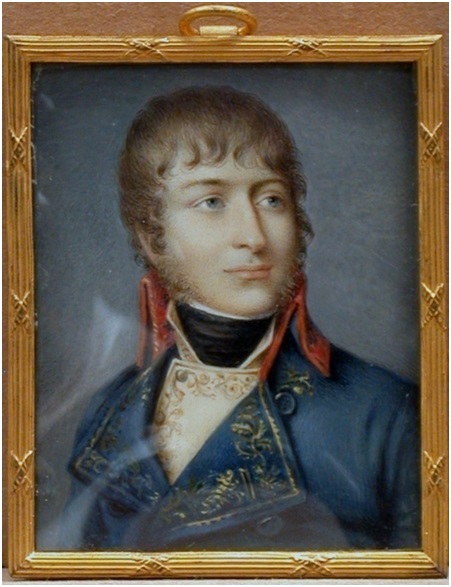
No. 130
130. [18th CENTURY FRENCH CONSULATE ERA PORTRAIT MINIATURE]. [French Napoleonic Officer of the Consulate]. 2 5/8 x 2 1/8 inches. gouache painting on ivory. gilded brass frame, with convex glass and reed and ribbon border design. French Consulate Era: c1799. $1,000
The Consulate [1799–1804]. French government established after the Coup of 18–19 Brumaire [Nov. 9–10, 1799], during the French Revolution. The Constitution of the Year VIII created an executive consisting of three consuls, but the First Consul, Napoleon Bonaparte, wielded all real power, while the other two, Emmanuel-Joseph Sieyès and Pierre-Roger Ducos [1747–1816], were figureheads. The principles of representation and legislative supremacy were discarded. The executive branch was given the power to draft new laws, and the legislative branch became little more than a rubber stamp. Elections became an elaborate charade, with voters stripped of real power. Napoleon abolished the Consulate when he declared himself emperor in 1804. (Encyclopedia Britannica).
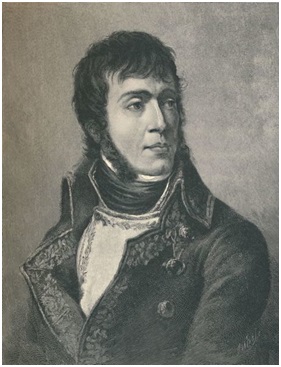 *This miniature may be a portrait of French Field Marshal André Masséna, Duke of Rivoli, Prince of Essling, c1796. He was one of the original 18 Marshals of the Empire created by Napoleon.
*This miniature may be a portrait of French Field Marshal André Masséna, Duke of Rivoli, Prince of Essling, c1796. He was one of the original 18 Marshals of the Empire created by Napoleon.
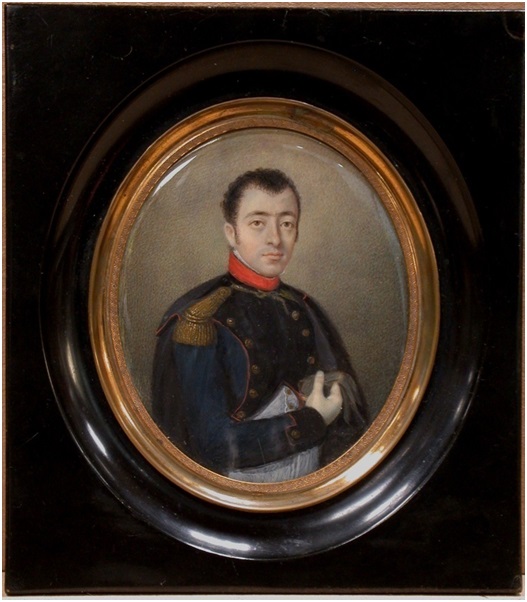
No. 131
131. [19th CENTURY FIRST FRENCH EMPIRE PORTRAIT MINIATURE]. [French Napoleonic Officer wearing the uniform of the Chasseurs de la Garde Impériale]. 3 5/8 x 3 inches (oval miniature). gouache painting on ivory. enameled gutta-percha frame (impressed mark on verso “HFV á Paris”), with convex glass and gilded metal liner. French First Empire: c1810. $1,200
The Chasseurs à Cheval de la Garde Impériale (in English: Horse Chasseurs of the Imperial Guard) constituted a light cavalry regiment in the Consular, then Imperial Guard during the French Consulate and First French Empire respectively. They were the second senior "Old Guard" cavalry regiment of the Imperial Guard, after the Grenadiers à Cheval. The regiment had its origins in the Guides raised by General Bonaparte during his Italian Campaign of 1796. It was the Chasseurs that usually provided personal escort to Napoleon, and he often wore the uniform of a colonel of the regiment in recognition of this service. The regiment was not only known for its lavish uniform, but its combat history as well.
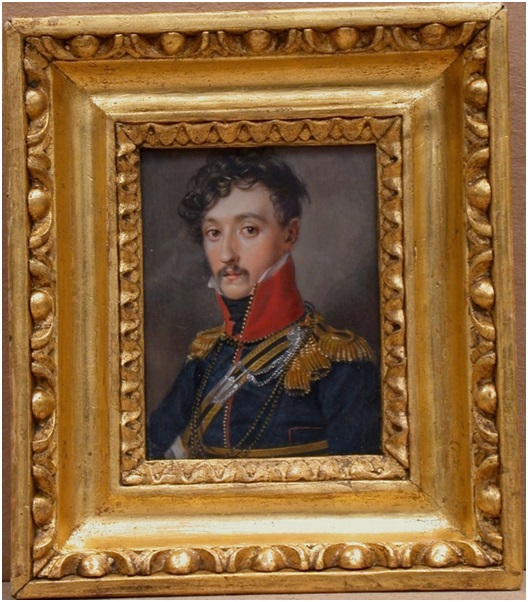
No. 132
132. [19th CENTURY NAPOLEONIC ERA PORTRAIT MINIATURE]. [Cavalry Captain (possibly from a Polish Regiment)]. 3 ¼ x 2 ½ inches (miniature), 6 x 5 ¼ inches (frame). gouache painting on ivory. gilded wood frame with egg and dart moulding decorations (remains of old Hungarian and German newsprint on verso backing). bearing inscriptions and date “1810” on paper attached to ivory verso. bearing old label attached to frame backing: “17. Sabattier. Capitn. de Daumier”. French First Empire: c1810. $1,400
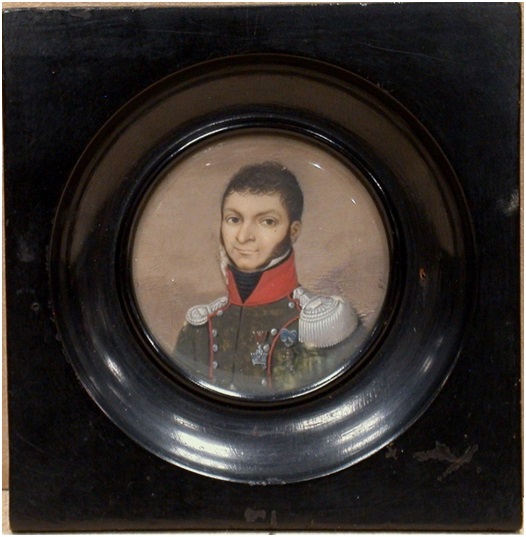
No. 133
133. [19th CENTURY ITALIAN NAPOLEONIC KINGDOM PORTRAIT MINIATURE]. [Italian Cavalry Officer wearing the uniform of the Chasseurs à Cheval de la Garde Impériale (Cacciatore a Cavallo della Guardia Imperiale)]. 2 inches dia. (circular miniature). gouache painting on ivory. black enameled wood frame with convex glass. bearing initials to right side border. Napoleonic Kingdom of Italy: c1805. $900
The Officer in this miniature can be seen wearing the Order of the Iron Crown of Italy. Founded on June 5, 1805, by Napoleon I as King of Italy, the order was the second highest in the French Empire after the Legion of Honour. France and Italy were governed under a personal union with Napoleon as head of state. His stepson Eugene de Beauharnais was appointed Viceroy of Italy and governed from the capital in Milan.
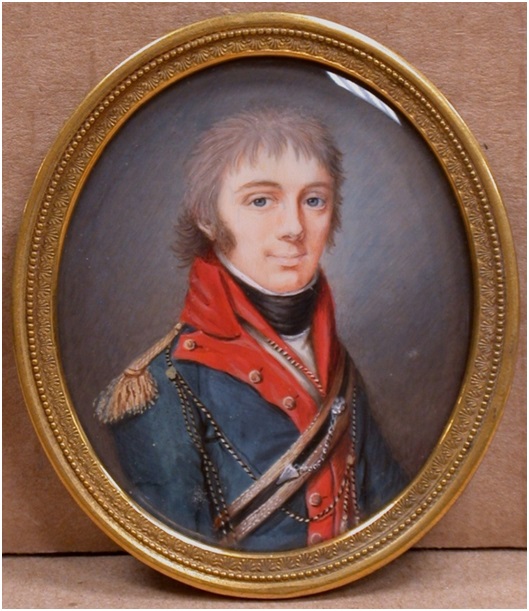
No. 134
134. [18th/19th CENTURY FRENCH PORTRAIT MINIATURE]. [French Dragoon Cavalryman]. 3 x 2 ½ inches (framed). gouache painting on ivory. oval glass with rounded edges, ormolu frame, decorated with palmette border. French: c1800. $1,000
“Among Napoleon's most versatile troops, the dragoons could fight on horse or be employed like dismounted troops to support infantry. In cavalry charges they used the same sabre issued to the heavy cavalry units of Cuirassiers and Carabiners. Additionally, they were equipped with a musket and pistols mod.1777.” (Italeri)
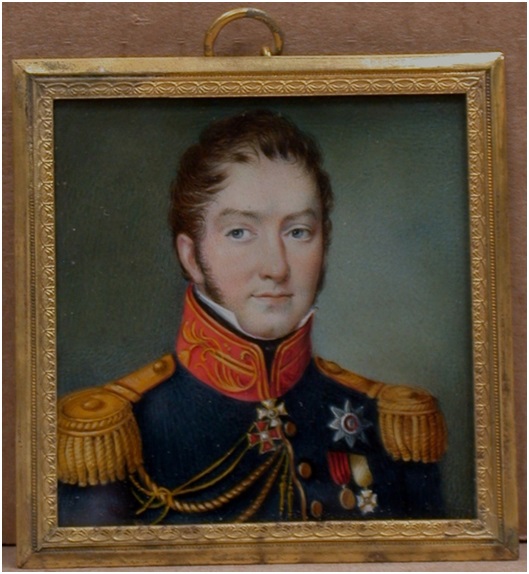
No. 135
135. [19th CENTURY RUSSIAN IMPERIAL PORTRAIT MINIATURE]. [Portrait of a Russian Major General]. 2 ¼ x 2 ¼ inches. gouache painting on ivory. original period ormolu frame. Russian Empire: c1815. $1,000
The officer in this miniature is wearing the uniform of a major general in the Preobrazhensky Guards Regiment. He is also wearing the Cross of the Order of Saint George (the highest military order); the Cross of the Order of Saint Vladimir; the Star of Order of Saint Anne; (as well as two other period orders).
All of the Russian officers who took part in the Napoleonic Wars had their portraits included in the Military Gallery of the Winter Palace, in Saint Petersburg, Russia. Most were painted by the English artist George Dawe and or his studio.
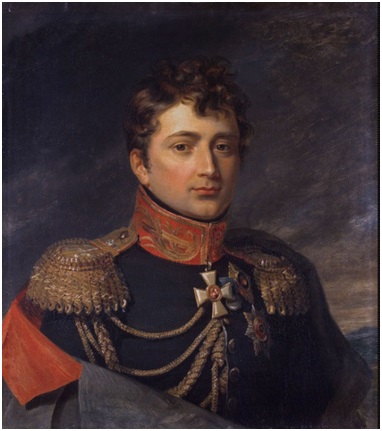
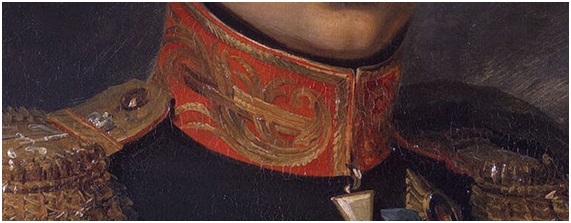
Generals with similar features to this portrait include: Guillaume de Saint-Priest, (a portrait of this general bears the exact same collar embroidery as depicted in this miniature), Adam Ożarowski, Alexander Urusov, and or Mikhail Vorontsov.
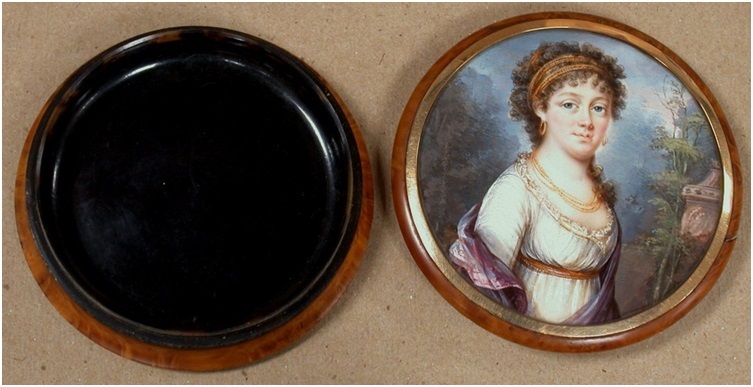
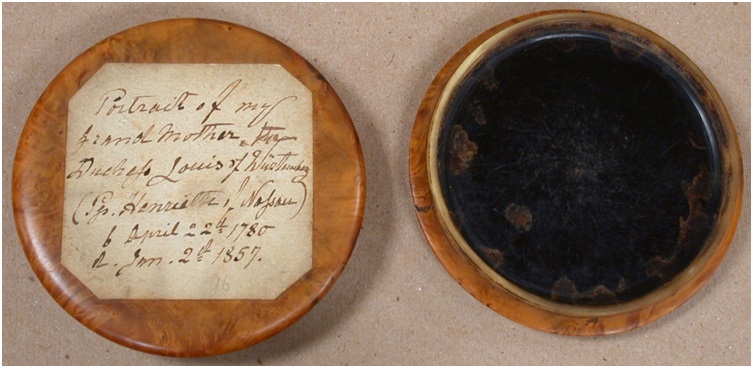
No. 136
136. [19th CENTURY GERMAN NAPOLEONIC EMPIRE PORTRAIT MINIATURE]. Portrait of Princess Henriette of Nassau-Weilburg, Duchess Louis of Wurttemberg. 3 ½ x 3 ½ x 1 inches (total). circular, lidded case, composed of turned burr wood, tortoise shell interior, convex glass with 9k gold framed lip, original gouache portrait painting on ivory to lid top. hand-written label attached to bottom: “Portrait of my Grand Mother the Duchess of Louis of Wurttemberg (Prs. Henriette of Nassau) b. April 22nd 1780, d. Jan. 2nd 1857.”also includes original hand-written note inscribed:“Henrietta Princess of Nassau-Weilburg, Duchess of Louis of Wurttemberg (my grandmother)” on paper printed with crowned monogram “TF” and “White Lodge, Richmond Park”. Napoleonic Kingdom of Wurttemberg: c1805. $4,000
Provenance: Collection of Prince Francis, Duke of Teck (in the Kingdom of Wurttemberg). The Duke of Teck was a grandson of the sitter, the husband of British Princess Mary Adelaide of Cambridge (a granddaughter of King George III and first cousin of Queen Victoria), the father of HM Queen Mary, the wife of King George V of the United Kingdom, and the father of Major-General Alexander Cambridge, 1st Earl of Athlone (born Prince Alexander of Teck), later the 4th Governor General of the Union of South Africa, and 16th Governor General of Canada.
Princess Henriëtte van Nassau-Weilburg, (then van Nassau) [born 22 April 1780, in Kirchheimbolanden – 2 January 1857, in Kirchheimunter Teck] was a daughter of Prince Charles Christian, Duke of Nassau-Weilburg and Carolina of Orange-Nassau, daughter of William IV, Prince of Orange. She was married in Hermitage, near Bayreuth, on 28th January 1797, to Duke Louis of Württemberg, a son of the reining Duke, Friedrich II Eugen, of Württemberg. They had five children.
Queen Elizabeth II of the United Kingdom is her descendant through Queen Mary and her father Francis Duke of Teck, who was Henriette's grandson. Prince Philip, the Duke of Edinburgh, is a descendant through his father Prince Andrew of Greece and Denmark, who was a grandson of Princess Alexandra of Saxe-Altenburg, who was her granddaughter. King Juan Carlos I of Spain is a descendant through his grandfather King Alfonso XIII of Spain who was a grandson of Archduchess Elisabeth Franziska of Austria, a granddaughter of Henriette.
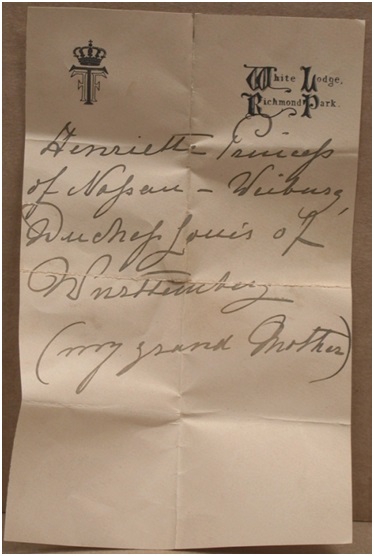
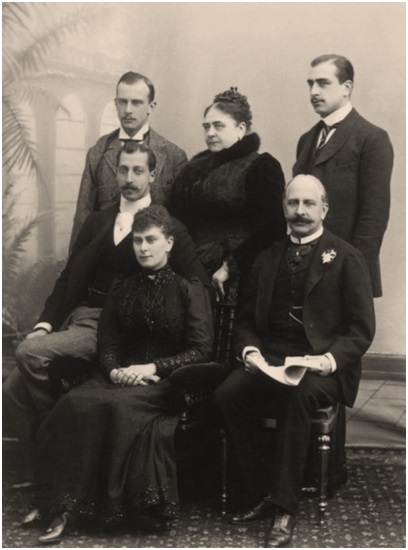
[*This photo not included with miniature]
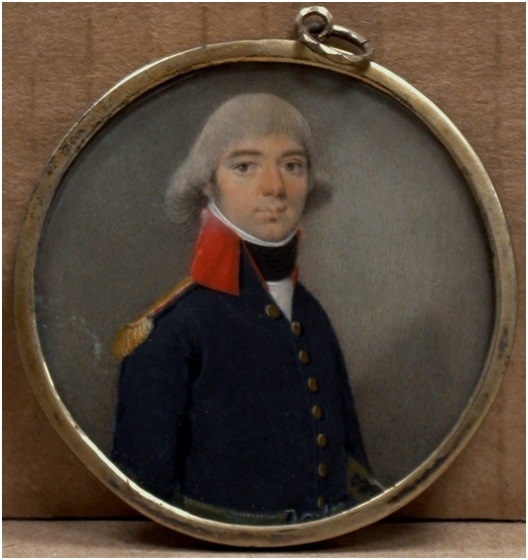
No. 137
137. [18th CENTURY FRENCH PORTRAIT MINIATURE]. [French Directory Era Official]. 2 3/8 inches dia. gouache painting on ivory. convex glass, circular brass frame. inscribed on verso: “Ignato”. French Directory Era: c1797. $800
“French Directoire, the French Revolutionary government set up by the Constitution of the Year III, lasted four years, from November 1795 to November 1799. It included a bicameral legislature known as the Corps Législatif. The lower house, or Council of Five Hundred (Conseil de Cinq-Cents), consisted of 500 delegates, 30 years of age or over, who proposed legislation; the Council of Ancients (Conseil des Anciens), consisted of 250 delegates, 40 years of age or over, who held the power to accept or veto the proposed legislation. The Ancients also picked the executive—the five Directors (Directeurs)—from lists drawn up by the Five Hundred. A Director had to be at least 40 years old and to have formerly served as a deputy or minister; a new one was chosen each year, on rotation. The Directors chose government ministers, ambassadors, army generals, tax collectors, and other officials. However, though nominally inheriting many of the centralized powers of the former Committee of Public Safety, they had no funds to finance their projects or courts to enforce their will. The Directory was a fatal experiment in weak executive powers; it was created in reaction to the puritanical dictatorship that had existed under the Reign of Terror of 1793–94, and it would end up yielding to the more disciplined dictatorship of Napoleon Bonaparte. The Directory suffered from widespread corruption. Its policies aimed at protecting the positions of those who had supported the Revolution and preventing the return of the Bourbons. Despite its unsavory reputation, it consolidated many of the achievements of the National Convention, such as the creation of a system of elite centralized schools, the grandes écoles. The French economy recovered from the disruption caused by the Terror, and the successes of the French armies laid the basis for the conquests of the Napoleonic period.” (Encyclopedia Britannica).
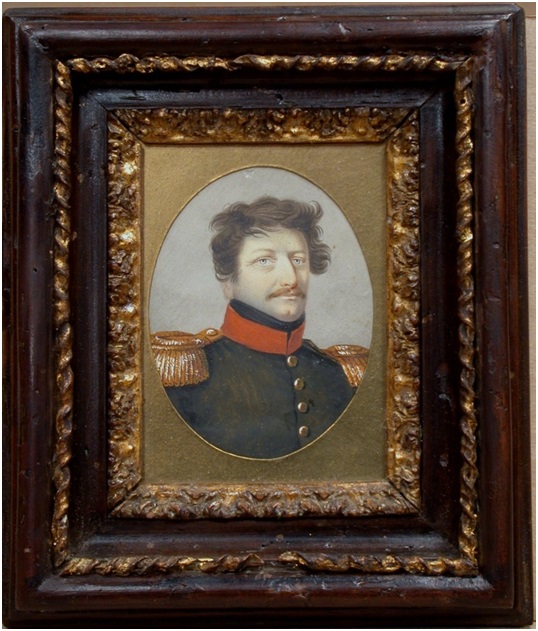
No.138
138. [19th CENTURY FRENCH NAPOLEONIC PORTRAIT MINIATURE]. [French Civil Official]. 4 ½ x 3 ¼ inches (oval matted). 8 3/8 x 7 1/8 inches (framed). gouache painting on card. In original carved and gilded wood frame. First French Empire: c1810. $900
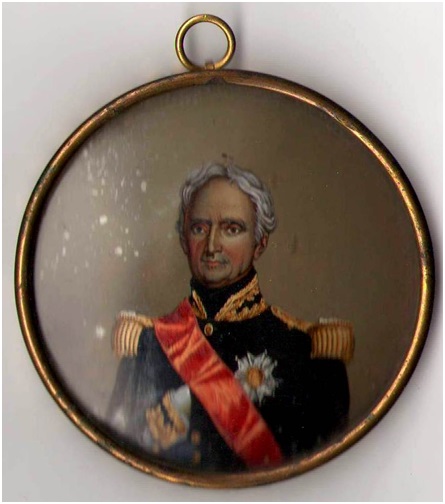
No. 139
139. [19th CENTURY PORTRAIT MINIATURE]. [Portrait of a Marshal of France of the Bourbon Restoration]. 2 ¾ inches in dia. (circular miniature). painted reverse print on glass with silvered backing. mounted in circular gilded metal frame. framed. Post-Napoleonic Restoration France: c1824. $400
The figure in this portrait is wearing the star of the Legion of Honour with the portrait head of King Henry IV. At the restoration, the new government kept the Legion relatively as-is, but removed the portrait of Napoleon from the central medallion of the jewel and replaced it with that of the first Bourbon King.
“Bourbon Restoration, (1814–30) in France, the period that began when Napoleon I abdicated and the Bourbon monarchs were restored to the throne. The First Restoration occurred when Napoleon fell from power and Louis XVIII became king. Louis’ reign was interrupted by Napoleon’s return to France (see Hundred Days), but Napoleon was forced to abdicate again, leading to the Second Restoration. The period was marked by a constitutional monarchy of moderate rule (1816–20), followed by a return of the ultras during the reign of Louis’ brother, Charles X (1824–30). Reactionary policies revived the opposition liberals and moderates and led to the July Revolution, Charles’s abdication, and the end of the Bourbon Restoration.” (Encyclopedia Britannica).
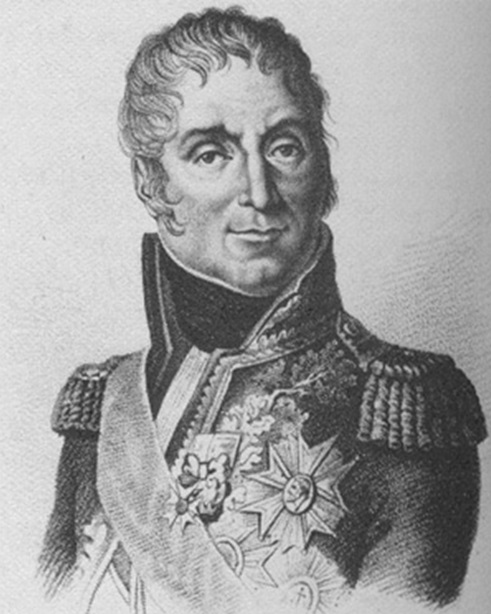 *this miniature may be a portrait of the former Napoleonic Marshal André Masséna in later life as a Bourbon Restoration officer.
*this miniature may be a portrait of the former Napoleonic Marshal André Masséna in later life as a Bourbon Restoration officer.
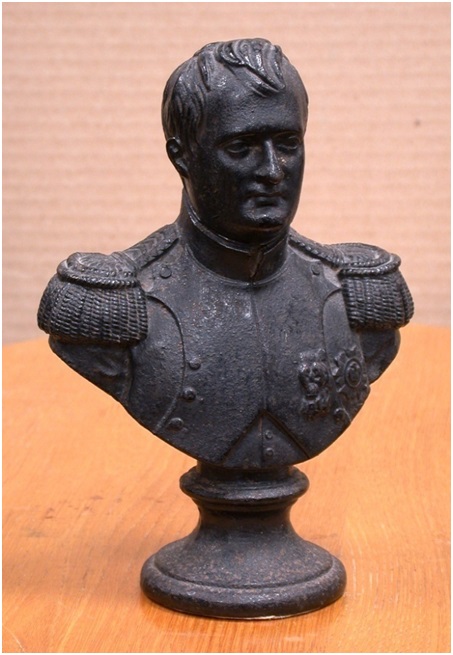
No. 140
140. [19th CENTURY FRENCH SCULPTURE]. after: JEAN-ANTOINE HOUDON [French Sculptor, 1741-1828]. [Napoleon I wearing the uniform of Colonel in the Chasseur à Cheval of the Imperial Guard]. 7 x 5 x 2 ½ inches. cast iron with black patination, portrait head and shoulders bust of Napoleon Bonaparte, mounted on socle base. France: 19th Century. $300
Hudon’s “religious and mythological works are definitive expressions of the 18th-century Rococo style of sculpture. Elements of classicism and naturalism are also evident in his work, and the vividness with which he expressed both physiognomy and character places him among history’s greatest portrait sculptors.”
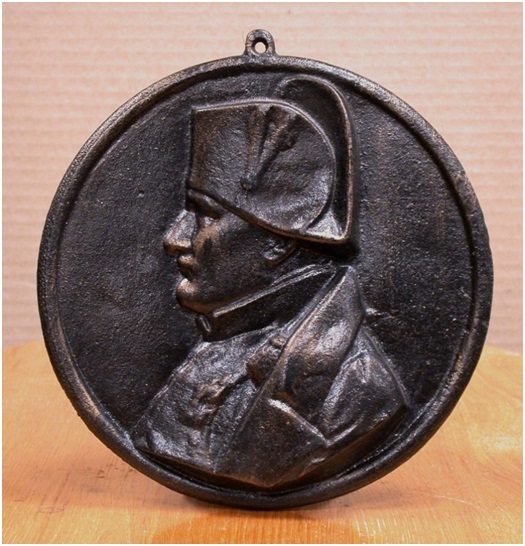
No. 141
141. [19th CENTURY FRENCH SCULPTURE]. after: DAVID D'ANGERS [French Sculptor / Medalist, 1788-1858]. [Napoleon I wearing cocked hat and greatcoat]. 7 ¼ inches in dia. cast-iron with black , relief medallion, with hanging ring, showing left-side portrait head and shoulders bust, of Napoleon Bonaparte. France: 19th Century. $100
“Many of the most famous men and women of his time sat for David for busts or medallions. A nearly complete collection, originals or copies, is in the Musée des Beaux-Arts, Angers. Among David’s most important works are the pediment of the Panthéon, showing the key liberal figures in France since the 18th century grouped round a figure of La Patrie; the Gutenberg monument at Strasbourg; the monument to General Gobert in the Père-Lachaise Cemetery in Paris; the Philopoemen in the Louvre; and the bust of Goethe, presented by him to the poet in 1831, in the public library at Weimar, Ger.” (Encyclopedia Britannica)

No. 142
142. [FRENCH REVOLUTION NAPOLEONICA]. after CORBET, Charles Louis [1758-1808]. Portrait Bust of General Napoleon Bonaparte. 8 3/4 x 5 1/2 x 4 inches. cast white marble composition, mounted on black base. signed in the cast. Italy: c1980. $100
Reproduction of an original 1798 government-commissioned plaster bust of Napoleon by Charles Louis Corbet, one of exceptionally few portraits of Napoleon made before his coup d’état in 1799. “The bust shows the young general as a consciously heroic, and even handsome man. The bust not only reflects Napoleon’s growing popularity in France at the time, after his brilliant victories in Italy, but may well have played a role in the creation of a personal cult around the future Emperor.” (“Historic Portraits Image Library” Philip Mould website).
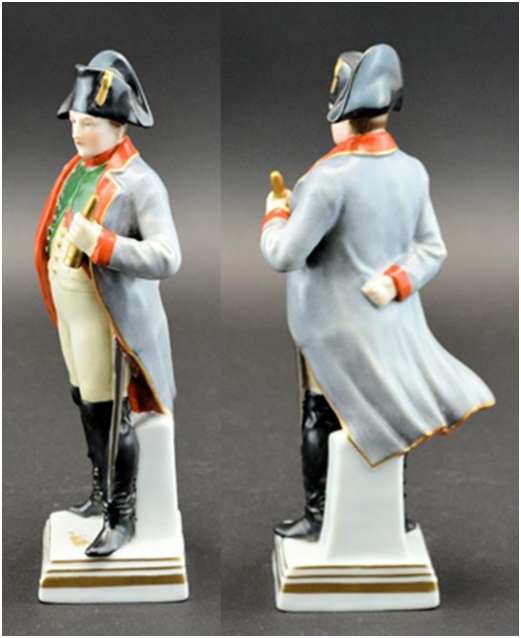
No. 143
143. [ITALIAN DOCCIA CAPODIMONTE PORCELAIN, COLLECTIBLE NAPOLEONICA]. Statuette of Napoleon Bonaparte in Military Uniform. 8 ¼ x 3 ½ x 2 ¼ inches. cast, hand-painted and glazed porcelain figurine with gold highlights. blue crowned “N” mark to bottom. [Italy: c1900]. $350
The Royal Factory of Capodimonte was founded in 1743 by Charles VII, Bourbon King of the Two Sicilies, and his wife Amalia of Saxony at their palace in Naples (“Reggia de Capodimonte) in order to create porcelain to rival that produced in Meissen. At one time its porcelain was considered greater than the German and French. The most flourishing period of the Royal Factory of Capodimonte lies in the last two decades of the eighteenth century when a Royal Art School led by Domenico Venuti was founded. He produced many valuable services of porcelain, which are now preserved in the Museum of Capodimonte. During the second half of the 19th century, the first handicraft factories were created, all family-managed companies. The production of fine Capodimonte porcelain continues to this day. [‘Capodimonte’s Finest’ website].
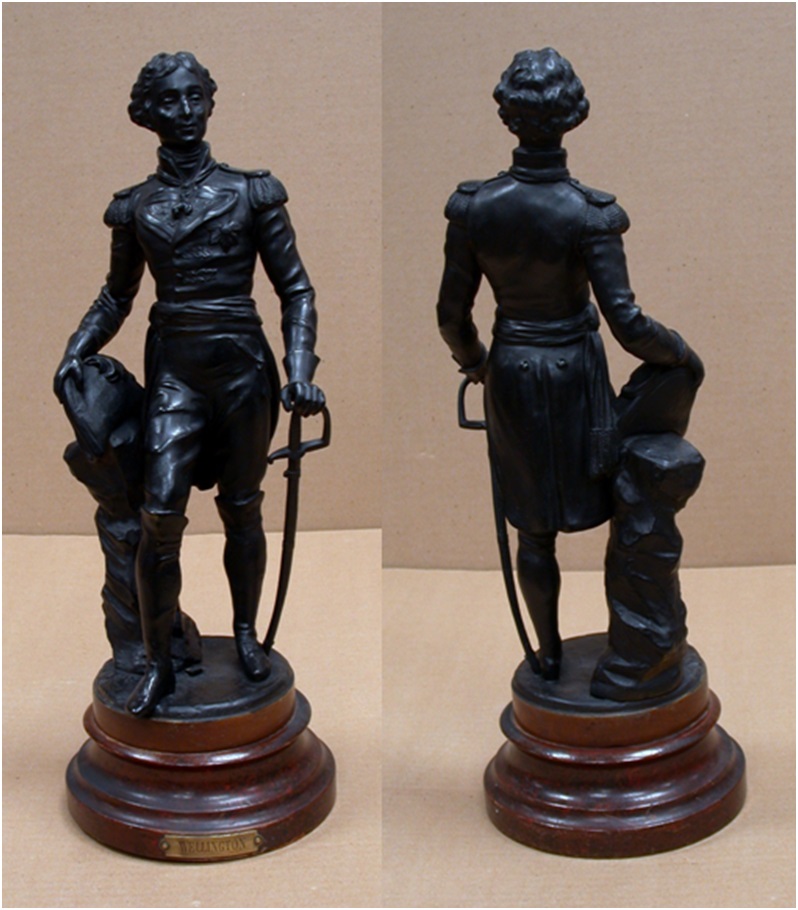
No. 144
144. [19TH CENTURY NAPOLEONIC/PENINSULAR WARS FIGURES]. “Wellington” (figure of Arthur Wellesley, 1st Duke of Wellington, in the Uniform of a Captain-General of the Spanish Army, wearing the neck badge of the Spanish Order of the Golden Fleece, and a star order). 18 x 6 1/4 x 6 inches. cast white metal sculpture with black patination, mounted on turned marbleized wood base, with brass title’s label applied to base. European manufacture: post 1814 (to second quarter of the 19th century). $800

No. 145
145. [19TH CENTURY NAPOLEONIC/PENINSULAR WARS FIGURES]. [Portrait of Arthur Wellesley, 1st Duke of Wellington]. 8 7/8 x 5 inches. cast iron with black patination, of head and shoulders portrait head relief sculpture, mounted on wood base. British: second quarter of the 19th century. $300